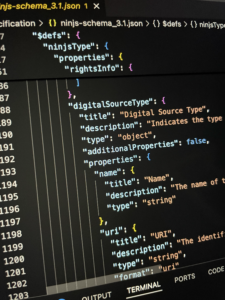Categories
Archives

The IPTC is excited to announce the latest updates to ninjs, our JSON-based standard for representing news content metadata. Version 3.1 is now available, along with updated versions 2.2 and 1.6 for those using earlier schemas.
These releases reflect IPTC’s ongoing commitment to supporting structured, machine-readable news content across a variety of technical and editorial workflows.
What is ninjs?
ninjs (News in JSON) is a flexible, developer-friendly format for describing news items in a structured way. It allows publishers, aggregators, and news tech providers to encode rich metadata about articles, images, videos, and more, using a clean JSON format that fits naturally into modern content pipelines.
What’s new in ninjs 3.1, 2.2 and 1.6?
The new releases add a new property for the IPTC Digital Source Type property, which was first used with the IPTC Photo Metadata Standard but now used across the industry to declare the source of media content, including content generated or manipulated by a Generative AI engine.
The new property (called digitalSourceType in 3.1 and digitalsourcetype in 2.2 and 1.6 to match the case conventions of each standard version) has the following properties:
- Name: the name of the digital source type, such as “Created using Generative AI”
- URI: the official identifier of the digital source type from the IPTC Digital Source Type vocabulary or another vocabulary, such as http://cv.iptc.org/newscodes/digitalsourcetype/trainedAlgorithmicMedia (the official ID for generative AI content)
- Literal: an optional way to add new digital source types that are not part of a controlled vocabulary.
IPTC supports multiple versions of ninjs in parallel to ensure stability and continuity for publishers and platforms that depend on long-term schema support.
The new property is part of the general ninjs schema, and so can be used in the main body of a ninjs object to describe the main news item and can also be used in an “association” object which refers to an associated media item.
Access the schemas
All versions are publicly available on the IPTC website:
ninjs generator and user guide
The ninjs Generator tool has been updated to cover the latest versions. Fill in the form fields and see what that content looks like in ninjs format. You can switch between the schema versions to see how the schema changes between 1.6, 2.2 and 3.1.
The ninjs User Guide has also been updated to reflect the newly added property.
Why it matters
As the news industry becomes increasingly reliant on metadata for content distribution, discoverability, and rights management, ninjs provides a modern, extensible foundation that supports both human and machine workflows. It’s trusted by major news agencies, technology platforms, and AI developers alike.
Get involved
We welcome feedback from the community and encourage you to share how you’re using ninjs in your own products or platforms. If you would like to discuss ninjs, you can join the public mailing list at https://groups.io/g/iptc-ninjs.
If you’re interested in contributing to the development of IPTC standards, join us!